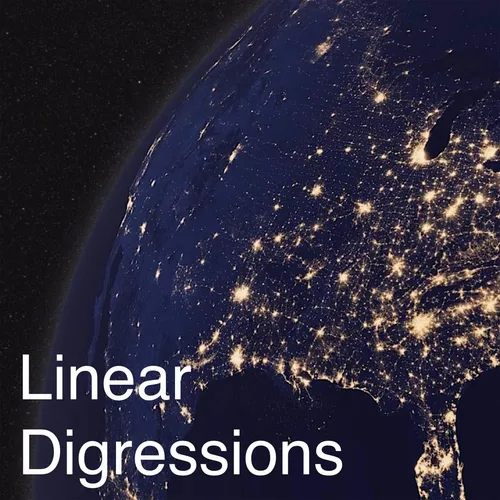
Linear Digressions
In each episode, your hosts explore machine learning and data science through interesting (and often very unusual) applications.
- Update frequency
- every 6 days
- Average duration
- 19 minutes
- Episodes
- 291
- Years Active
- 2014 - 2020

Sold! Auctions (Part 2)
The Google ads auction is a special kind of auction, one you might not know as well as the famous English auction (which we talked about in the last episode). But if it's what Google uses to sell bi…
00:17:27 |
Mon 25 Jan 2016

Going Once, Going Twice: Auctions (Part 1)
The Google AdWords algorithm is (famously) an auction system for allocating a massive amount of online ad space in real time--with that fascinating use case in mind, this episode is part one in a two…
00:12:39 |
Fri 22 Jan 2016

Chernoff Faces and Minard Maps
A data visualization extravaganza in this episode, as we discuss Chernoff faces (you: "faces? huh?" us: "oh just you wait") and the greatest data visualization of all time, or at least the Napoleonic…
00:15:11 |
Mon 18 Jan 2016

t-SNE: Reduce Your Dimensions, Keep Your Clusters
Ever tried to visualize a cluster of data points in 40 dimensions? Or even 4, for that matter? We prefer to stick to 2, or maybe 3 if we're feeling well-caffeinated. The t-SNE algorithm is one of …
00:16:55 |
Fri 15 Jan 2016
![The [Expletive Deleted] Problem](https://b2.eachpod.com/podcast-imgs/752c4b22ec967eb5d538d96280ece729.webp)
The [Expletive Deleted] Problem
The town of [expletive deleted], England, is responsible for the clbuttic [expletive deleted] problem. This week on Linear Digressions: we try really hard not to swear too much.
Related links:
http…
00:09:54 |
Mon 11 Jan 2016

Unlabeled Supervised Learning--whaaa?
In order to do supervised learning, you need a labeled training dataset. Or do you...?
Relevant links:
http://www.cs.columbia.edu/~dplewis/candidacy/goldman00enhancing.pdf
00:12:35 |
Fri 08 Jan 2016

Hacking Neural Nets
Machine learning: it can be fooled, just like you or me. Here's one of our favorite examples, a study into hacking neural networks.
Relevant links:
http://arxiv.org/pdf/1412.1897v4.pdf
00:15:28 |
Tue 05 Jan 2016

Zipf's Law
Zipf's law is related to the statistics of how word usage is distributed. As it turns out, this is also strikingly reminiscent of how income is distributed, and populations of cities, and bug report…
00:11:43 |
Thu 31 Dec 2015

Indie Announcement
We've gone indie! Which shouldn't change anything about the podcast that you know and love, but we're super excited to keep bringing you Linear Digressions as a fully independent podcast.
Some link…
00:01:19 |
Wed 30 Dec 2015

Portrait Beauty
It's Da Vinci meets Skynet: what makes a portrait beautiful, according to a machine learning algorithm. Snap a selfie and give us a listen.
00:11:44 |
Sun 27 Dec 2015

The Cocktail Party Problem
Grab a cocktail, put on your favorite karaoke track, and let’s talk some more about disentangling audio data!
00:12:04 |
Fri 18 Dec 2015

A Criminally Short Introduction to Semi Supervised Learning
Because there are more interesting problems than there are labeled datasets, semi-supervised learning provides a framework for getting feedback from the environment as a proxy for labels of what's "c…
00:09:12 |
Fri 04 Dec 2015

Thresholdout: Down with Overfitting
Overfitting to your training data can be avoided by evaluating your machine learning algorithm on a holdout test dataset, but what about overfitting to the test data? Turns out it can be done, easil…
00:15:52 |
Fri 27 Nov 2015

The State of Data Science
How many data scientists are there, where do they live, where do they work, what kind of tools do they use, and how do they describe themselves? RJMetrics wanted to know the answers to these questio…
00:15:40 |
Tue 10 Nov 2015

Data Science for Making the World a Better Place
There's a good chance that great data science is going on close to you, and that it's going toward making your city, state, country, and planet a better place. Not all the data science questions bei…
00:09:31 |
Fri 06 Nov 2015

Kalman Runners
The Kalman Filter is an algorithm for taking noisy measurements of dynamic systems and using them to get a better idea of the underlying dynamics than you could get from a simple extrapolation. If y…
00:14:42 |
Thu 29 Oct 2015

Neural Net Inception
When you sleep, the neural pathways in your brain take the "white noise" of your resting brain, mix in your experiences and imagination, and the result is dreams (that is a highly unscientific explan…
00:15:19 |
Fri 23 Oct 2015

Benford's Law
Sometimes numbers are... weird. Benford's Law is a favorite example of this for us--it's a law that governs the distribution of the first digit in certain types of numbers. As it turns out, if you'…
00:17:42 |
Fri 16 Oct 2015

Guinness
Not to oversell it, but the student's t-test has got to have the most interesting history of any statistical test. Which is saying a lot, right? Add some boozy statistical trivia to your arsenal in…
00:14:43 |
Wed 07 Oct 2015

PFun with P Values
Doing some science, and want to know if you might have found something? Or maybe you've just accomplished the scientific equivalent of going fishing and reeling in an old boot? Frequentist p-values…
00:17:07 |
Wed 02 Sep 2015
Disclaimer: The podcast and artwork embedded on this page are the property of Ben Jaffe and Katie Malone ([email protected]). This content is not affiliated with or endorsed by eachpod.com.